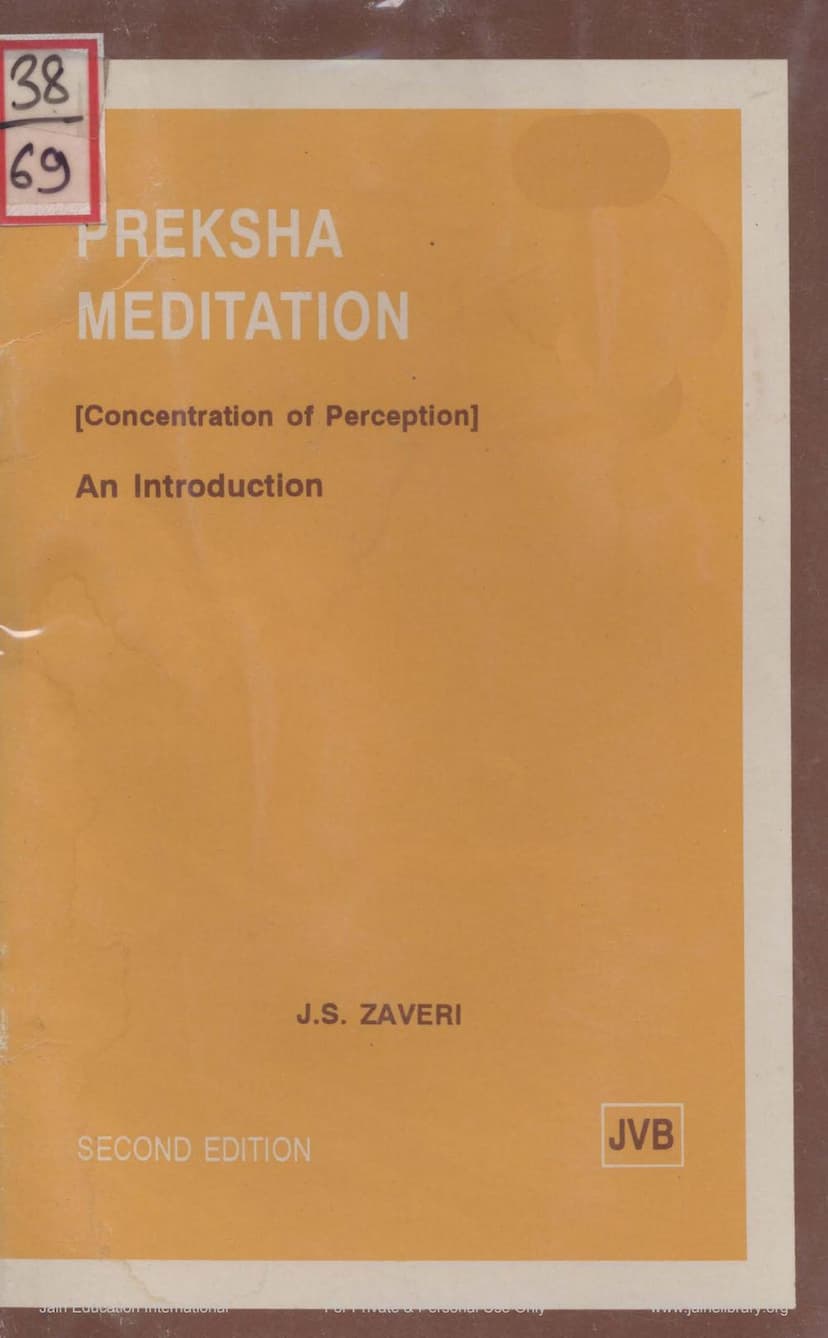Preksha Meditation
Added to library: September 2, 2025

Summary
Here is a comprehensive summary of the Jain text "Preksha Meditation: An Introduction" by Jethalal S. Zaveri:
The book "Preksha Meditation: An Introduction" by J.S. Zaveri, published by Jain Vishva Bharati, presents Preksha Meditation as a scientific system for personal transformation. It aims to achieve attitudinal change, behavioral modification, and integrated personality development by synthesizing ancient Jain philosophy with modern scientific understanding.
Core Principles and Scientific Basis:
- Meditation's Scientific Credibility: The book argues that meditation is no longer solely viewed as a mystical eastern practice but is now recognized by science for its profound effects on well-being. Modern science, particularly endocrinology and neuroscience, has begun to validate ancient philosophical insights.
- The Neuro-Endocrine System: A significant portion of the book explains the crucial role of the neuro-endocrine system, comprised of glands and nerves, in governing human emotions, mental states, and behavior. Hormones and neurohormones, secreted by endocrine glands, are identified as the primary drivers of primal urges, emotions like love, hate, and fear, and ultimately, human actions. The brain, while storing memories, is not the primary seat of impulses; rather, it's the neuro-endocrine system.
- Stress and the "Fight or Flight" Response: The text details how stressful situations trigger the "fight or flight" (FOF) mechanism, involving the adrenal glands and sympathetic nervous system, leading to physiological changes like increased heart rate and blood pressure. While beneficial for primal survival, chronic activation of this mechanism in modern life, without an outlet for physical action, leads to ailments like hypertension and ulcers.
- The Relaxation Response (Trophotropic Response): Conversely, meditation is presented as a way to activate the opposing "trophotropic response" or "relaxation response." This mechanism, associated with increased parasympathetic activity, counteracts the effects of stress, promoting restorative processes and physiological balance.
- Meditation Beyond Relaxation: While relaxation is a significant benefit, the book emphasizes that it is not the ultimate goal of meditation. True meditation aims for much deeper transformation, including the regulation and control of primal instincts (anger, aggression, fear), the awakening and development of conscious reason, and the eradication of inner discord and "bestial urges."
- Uniqueness of Man and Psychological Conflicts: The book highlights the unique human capacity for rational and conceptual thinking and the unification of mental processes. However, it also points out that this unification can lead to psychological conflicts when opposing urges arise. Repression (unconscious banishment of impulses) can lead to dangerous distortions, while suppression (conscious control) is more beneficial.
- Transmuting Mental Patterns: The core message is that human nature, particularly its behavioral and emotional expressions, can be fundamentally changed through controlled mental practices like meditation. By influencing the neuro-endocrine system through focused mental activity, one can transmute negative tendencies and cultivate positive ones.
Preksha Meditation: A Unique System:
- Meaning of Preksha: "Preksha" means to "see" or "perceive." Preksha Dhyana is defined as the "concentration of perception" rather than thought. It involves observing subtle internal phenomena with impartial mental insight, devoid of like or dislike.
- Mind Control Through Perception: The mind is naturally restless. Instead of trying to stop thoughts entirely (which is difficult and can increase restlessness), Preksha Meditation engages the mind in concentrated perception. Since thinking and perception cannot occur simultaneously, focusing on perception effectively calms the mind.
- Key Techniques:
- Shvasa Preksha (Perception of Breathing): This is the foundational practice. By focusing attention on the inhale and exhale, one gains control over the normally automatic breathing process. This simple act can influence brainwave rhythms and, through its connection to the nervous system, help control the mind and mitigate stress.
- Sharira Preksha (Perception of the Body): This involves systematically focusing attention on different parts of the body, observing the physiological sensations and processes. This practice helps revitalize cells, improve digestion, and enhance circulation. It's a method of experiencing the underlying consciousness through its physical manifestations.
- Chaitanya Kendra Preksha (Perception of Psychic Centres): This practice involves perceiving the endocrine glands ("psychic centres"). By focusing on these centres, practitioners can influence the secretion of hormones, thereby altering blood chemistry and helping to overcome negative habits (like addiction) and control impulses and emotional states. It also involves understanding and potentially altering the body's subtle vibrations.
- Vigilance and Self-Discipline: A crucial aspect of Preksha is maintaining vigilance and an impartial attitude towards all perceptions, especially avoiding emotional contamination (like pleasure or pain) that can cloud judgment. The goal is to awaken and strengthen the "reasoning mind" and establish self-discipline to control instincts and temptations.
- Empirical Results: The book lists various empirical results attributed to Preksha Meditation, including:
- Balance in activity and rest, relaxation.
- Mental vigilance, harmony in thought and deed.
- Development of willpower and determination.
- Purity of mind, genuine experience of reality.
- Positive change in mental attitude and behavioral patterns (increased tolerance, humility).
- Peace of mind and co-ordination of social interests.
- Freedom from addiction.
- Prevention and cure of psychosomatic diseases.
- Effortless concentration and freedom from nervous tension.
Conclusion:
In essence, "Preksha Meditation: An Introduction" posits Preksha as a practical, scientifically grounded system that goes beyond mere relaxation. It is presented as a powerful tool for self-mastery, enabling individuals to transmute their primal urges, develop their rational mind, and achieve both physical health and profound moral and spiritual well-being, ultimately leading to a more compassionate, balanced, and blissful life.